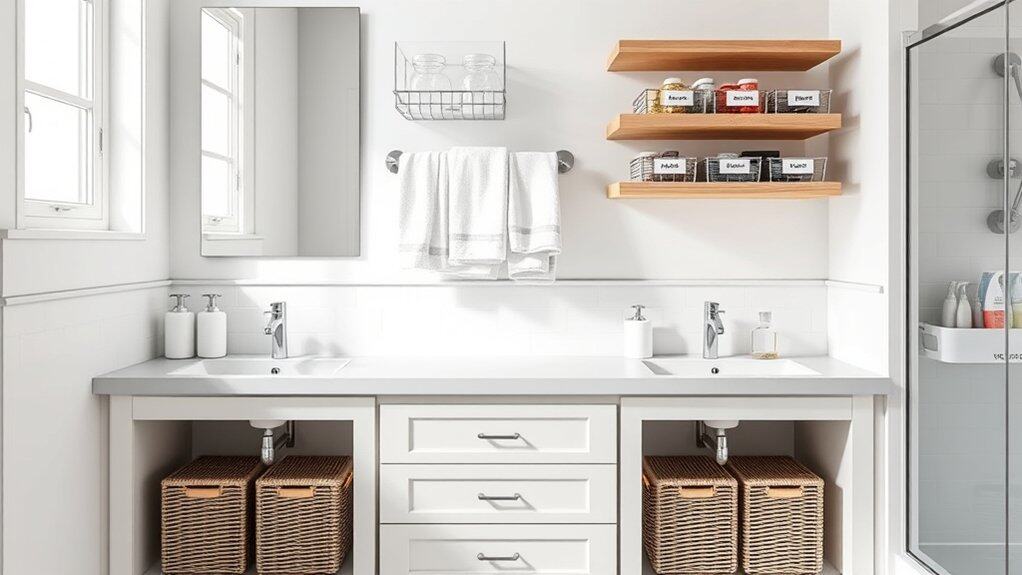You’re about to discover how to transform your chaotic shared bathroom into a peaceful sanctuary! As someone who’s survived multiple roommate situations, I’ve learned that bathroom harmony isn’t just about keeping things tidy – it’s an art form. From clever storage hacks to diplomatic solutions for sharing space, these seven proven tips will help you avoid those awkward “who left their stuff everywhere?” conversations. Let’s explore how to make your shared bathroom work for everyone.
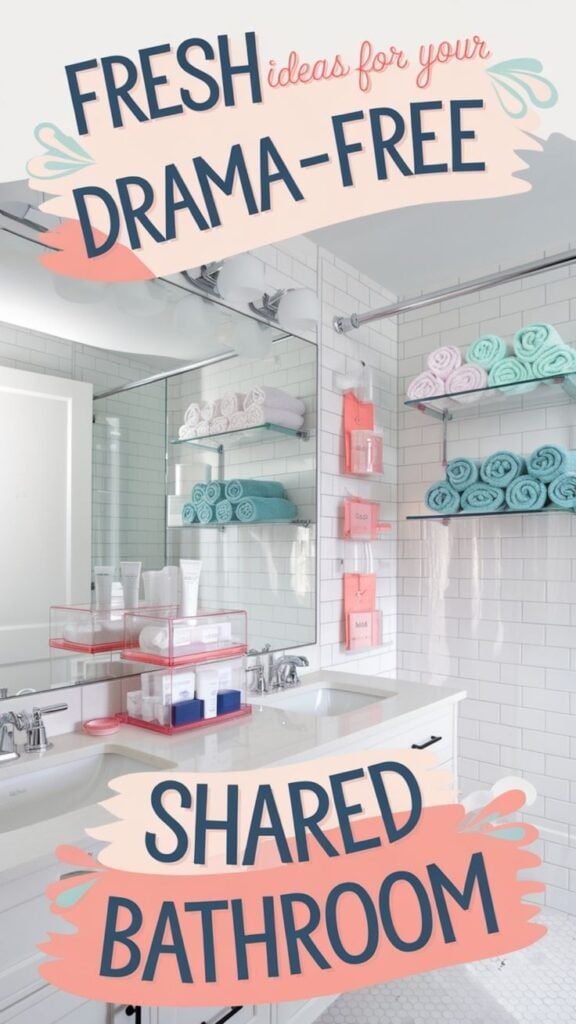
Establish Personal Storage Zones
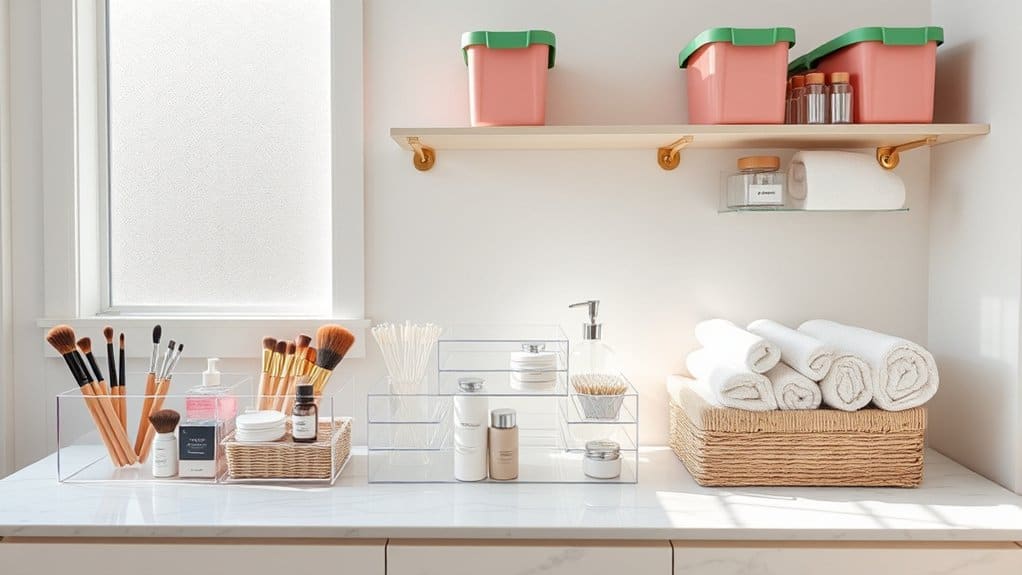
Creating designated storage zones in your bathroom is essential for maintaining order and efficiency in a space used by multiple people. When each person has their own clearly defined area, morning routines become smoother, and cleaning becomes more manageable as items stay in their designated spots.
Personal storage zones eliminate the frustration of searching for items and prevent conflicts over shared space. This systematic approach ensures that toiletries, medications, and personal care items remain organized and easily accessible while respecting everyone’s privacy and individual needs.
Required Items:
- Storage bins or baskets
- Drawer dividers
- Labels or label maker
- Clear containers
- Shelf organizers
- Over-the-door hooks
- Drawer units
- Waterproof markers
- Measuring tape
- Adhesive hooks
Begin by measuring your available space and assigning specific areas to each household member. Designate drawers, shelves, or cabinet space based on individual needs and the types of items each person regularly uses.
Install drawer dividers to create compartments for smaller items, and use clear containers to keep similar items together within each person’s zone. Label all containers and spaces clearly to maintain the system.
For shared items like toilet paper or cleaning supplies, create a separate communal zone that’s accessible to everyone. Consider vertical space by installing hooks or over-the-door organizers for items like towels and robes.
Ensure that frequently used items are placed at eye level or within easy reach, while occasional-use items can be stored in higher or lower spaces.
Additional Success Tips: Review and adjust zones periodically to accommodate changing needs and habits. Implement a regular decluttering schedule to prevent zones from becoming overcrowded.
Consider using color-coding for different family members to make identification even easier, and establish rules about returning items to their designated spots after use. This helps maintain the system long-term and ensures everyone’s continued cooperation in keeping the space organized.
Maximize Vertical Space With Smart Shelving
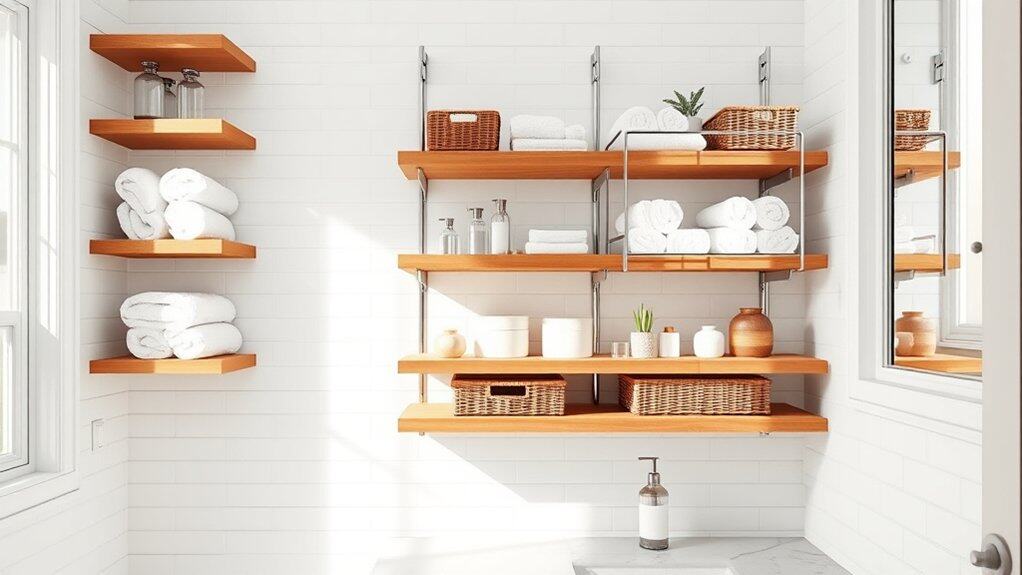
Making the most of vertical space in your bathroom is crucial, especially in smaller homes where every inch counts. Proper shelving solutions can transform an otherwise cramped bathroom into an organized oasis, providing dedicated spots for toiletries, towels, and other essentials while keeping counter space clear and clutter-free.
Vertical organization not only improves functionality but also creates a visually appealing space that feels larger and more streamlined. Smart shelving solutions can turn unused wall space into valuable storage areas, making items more accessible while maintaining a clean, organized appearance.
Required Items:
- Wall-mounted shelving units
- Floating shelves
- Over-the-toilet organizer
- Wall anchors and screws
- Level
- Drill
- Measuring tape
- Pencil
- Storage baskets or containers
- Command hooks
- Shelf liner (optional)
Start by measuring your available wall space and mapping out your shelving arrangement. Install the largest unit first, typically an over-the-toilet organizer, ensuring it’s properly anchored to wall studs.
Next, mount floating shelves at varying heights, keeping frequently used items at eye level and less-used items higher up. Create zones on your shelves – designate specific areas for cleaning supplies, personal care items, and decorative elements.
Group similar items together using matching storage containers or baskets to maintain visual consistency. Place heavier items on lower shelves for stability and safety. Consider installing a combination of open shelving for decorative items and closed storage for less attractive necessities.
Additional Tips: Use clear containers to easily identify contents, and incorporate labels for better organization. Install adjustable shelving when possible to accommodate changing storage needs.
Remember to leave some negative space between items to prevent a cluttered appearance, and periodically reassess your arrangement to ensure it continues meeting your needs efficiently.
Implement a Color-Coding System
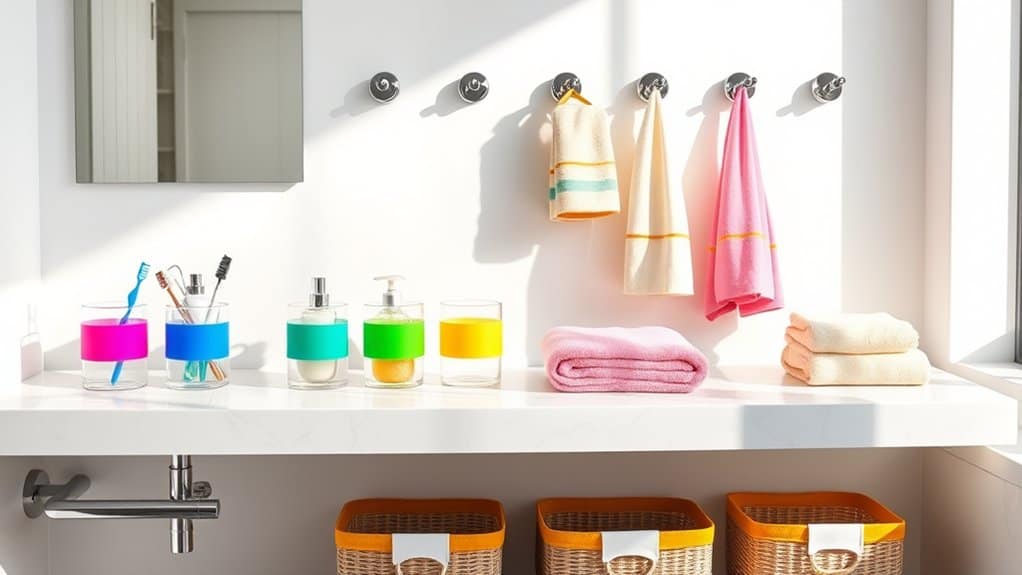
Color-coding your bathroom items creates an intuitive organization system that makes finding and storing items effortless. When everything has a designated color category, family members can quickly locate their belongings and return them to their proper places without confusion or hesitation.
A well-executed color-coding system transforms a cluttered bathroom into a streamlined space where items are instantly recognizable. This organizational method is particularly effective in shared bathrooms, where multiple family members need to keep their personal items separate and easily identifiable.
Required Items:
- Colored storage containers
- Label maker or permanent markers
- Colored tape or washi tape
- Storage baskets in different colors
- Colored towel sets
- Small colored bins
- Clear containers (optional)
- Drawer dividers
- Color-coded hooks
Assign specific colors to each family member or category of items. For example, designate blue for dental care items, green for hair products, and yellow for skincare essentials. Use colored storage containers or apply colored tape to clear containers to maintain the system.
Sort items into their designated color categories, ensuring all related products stay together. Install colored hooks or hangars for towels and robes, matching them to each person’s assigned color scheme. Label containers clearly with both the color designation and contents for added clarity.
Final organization tips: Regularly audit your color-coded system to ensure compliance and make adjustments as needed. Consider using lighter and darker shades of the same color for subcategories within a main category.
Keep a small chart or legend posted inside a cabinet door to help family members remember their assigned colors. Replace generic packaging with color-coordinated containers when possible to maintain a cohesive look and strengthen the organizational system.
Create a Daily Cleanup Schedule

A daily bathroom cleanup schedule is essential for maintaining a hygienic and organized space that promotes wellness and reduces the time spent on deep cleaning sessions. Regular maintenance prevents the buildup of soap scum, mildew, and clutter while ensuring bathroom essentials are always readily available.
Implementing a structured cleaning routine transforms your bathroom from a constantly messy space into a consistently clean sanctuary. This systematic approach not only maintains cleanliness but also helps identify when supplies need replenishing and prevents last-minute scrambles when guests arrive.
Required Items:
- Calendar or schedule template
- Cleaning spray
- Microfiber cloths
- Glass cleaner
- Toilet brush
- Disinfectant wipes
- Small garbage bags
- Timer
- Storage containers
- Cleaning gloves
Creating an effective daily cleanup schedule starts with breaking down tasks into manageable segments. Designate specific days for particular tasks, such as Monday for mirror cleaning, Tuesday for toilet sanitizing, and Wednesday for shower maintenance. Establish a consistent time each day, preferably after morning routines when the bathroom sees heavy use.
Allocate 10-15 minutes per day for basic maintenance tasks like wiping counters, replacing towels, and removing trash. The schedule should include quick daily tasks and rotating weekly duties. Daily tasks encompass wiping down counters, hanging towels properly, and spraying shower walls after use. Weekly tasks should include thorough toilet cleaning, floor mopping, and restocking supplies.
Post the schedule visibly in the bathroom and check off completed tasks to maintain accountability. To maximize the effectiveness of your cleanup schedule, keep cleaning supplies easily accessible in a dedicated cabinet or caddy. Consider creating a backup supply kit to avoid running out of essential items.
Setting phone reminders or linking cleaning tasks to existing habits, such as post-shower routines, helps maintain consistency and ensures the schedule becomes a natural part of daily life.
Install Space-Saving Storage Solutions
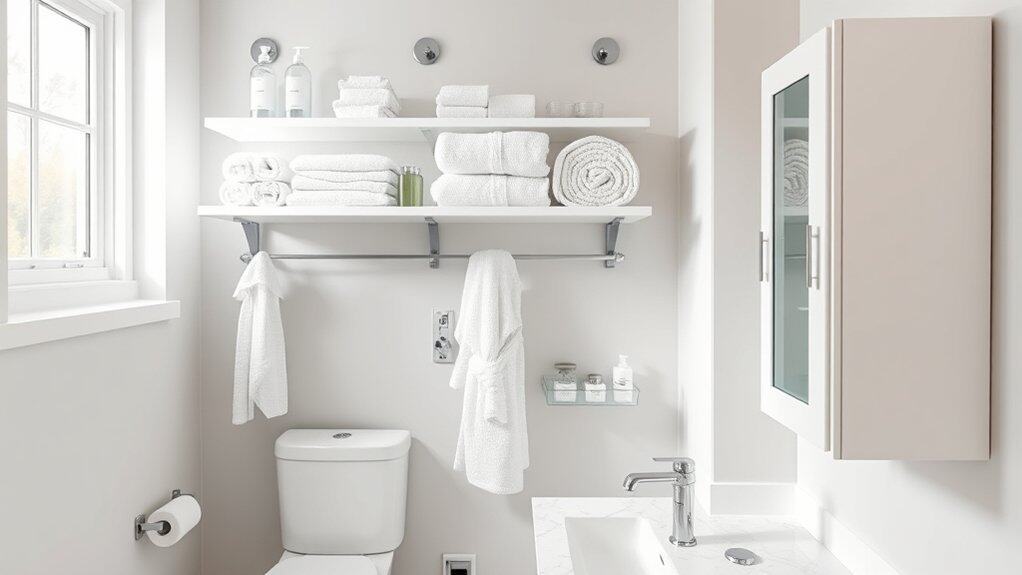
A well-organized bathroom with efficient storage solutions can transform a cluttered, chaotic space into a functional and serene environment. Maximizing vertical space and utilizing clever storage solutions helps maintain order while making the most of limited square footage.
Installing space-saving storage solutions is particularly crucial in bathrooms, where multiple family members often share toiletries, towels, and personal care items. Strategic storage placement ensures everything remains accessible while keeping countertops clear and floor space open.
Required Items:
- Over-the-toilet shelving unit
- Adhesive hooks or towel bars
- Door-mounted organizer
- Tension rods
- Clear storage containers
- Drawer organizers
- Wall-mounted cabinet
- Power drill and screws
- Level
- Measuring tape
- Stud finder
Start by assessing your bathroom’s vertical space, particularly unused wall areas and the space above the toilet. Mount an over-the-toilet shelving unit or cabinet, ensuring it’s properly secured to wall studs.
Install adhesive hooks or towel bars on empty wall spaces for hanging towels and robes. Utilize the back of the door by mounting an organizer for additional storage of smaller items.
For under-sink organization, install tension rods vertically to hang spray bottles and cleaning supplies. Add clear storage containers with labels to categorize and contain smaller items.
If space permits, mount a slim cabinet on an unused wall, ensuring proper installation with wall anchors for heavy items.
To maximize these storage solutions, rotate items seasonally and regularly assess their functionality. Store frequently used items at eye level and less-used items on higher shelves.
Consider using drawer organizers with adjustable compartments to prevent small items from becoming jumbled, and implement a regular cleaning schedule to maintain the organizational system.
Organize Shower and Tub Areas
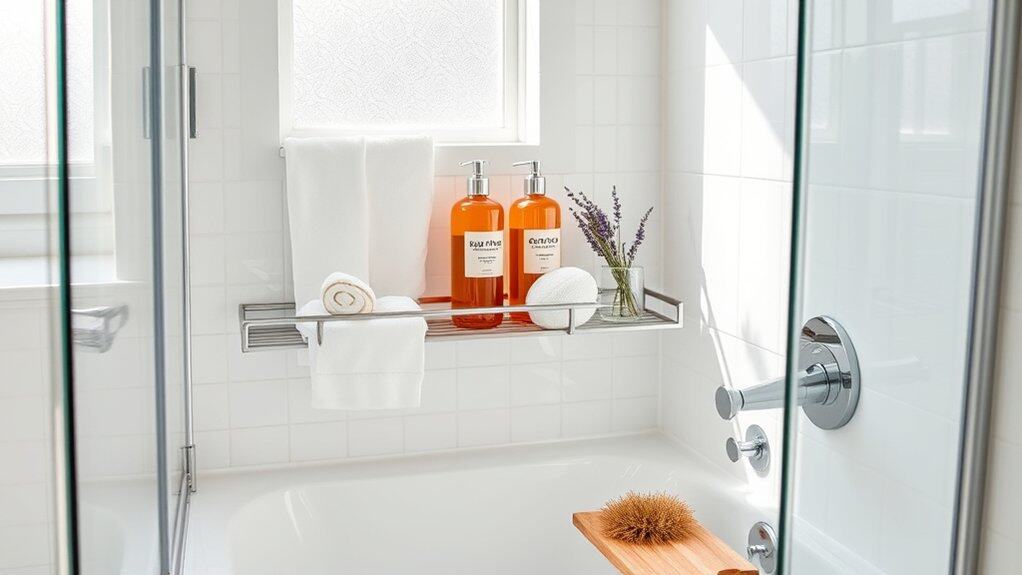
A well-organized shower and tub area is essential for maintaining a clutter-free bathroom and streamlining your daily routine. When toiletries and bath items are properly arranged, you can easily access what you need, reduce cleaning time, and create a more spa-like atmosphere in your personal space.
Organizing your shower and tub area not only improves functionality but also extends the life of your bath products by keeping them properly stored and protected from excess moisture. A systematic approach to organization can transform a chaotic shower space into an efficient and aesthetically pleasing environment.
Required Items:
- Shower caddy or corner shelf unit
- Suction cup hooks
- Waterproof storage containers
- Shower curtain with pockets
- Tension rod (if needed)
- Mesh storage bags
- Labels
- Squeegee
- Small trash bin
Start by removing everything from your shower and tub area, thoroughly cleaning the space, and sorting items into categories: daily use products, occasional use items, and items to discard.
Install a sturdy shower caddy or corner shelf unit at a convenient height, ensuring it’s properly secured. Position frequently used items like shampoo, conditioner, and body wash on the middle shelves for easy access.
Utilize suction cup hooks to hang loofahs, washcloths, and razors, keeping them off wet surfaces to prevent bacteria growth. For families sharing the bathroom, assign designated spaces or color-coded containers for each person’s items.
Install a second tension rod behind your shower curtain to hang mesh bags containing bath toys or additional storage containers.
Additional Tips: Consider implementing a rotation system for products, keeping only current-use items in the shower while storing backups elsewhere. Regularly inspect your organization systems for stability and clean them monthly to prevent mildew.
Place a small trash bin nearby for empty bottles and packaging to maintain the organized space. Label containers clearly and establish a “one in, one out” rule to prevent future clutter accumulation.
Set Clear Rules for Shared Items
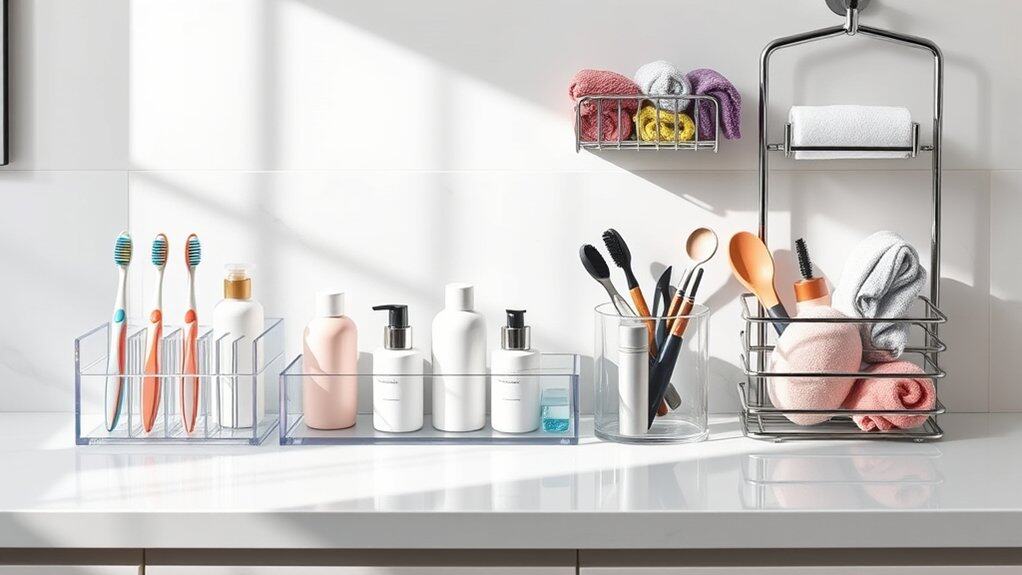
Establishing clear rules for shared bathroom items is crucial for maintaining harmony in households with multiple users. When everyone understands and follows specific guidelines for communal items, it reduces confusion, prevents conflicts, and ensures a more organized bathroom space.
In shared bathrooms, items like toilet paper, hand soap, and cleaning supplies often become sources of frustration when rules aren’t established. Creating a system for managing these shared resources not only maintains order but also ensures that essential items are consistently available when needed.
Required Items:
- Labels or label maker
- Storage containers
- Designated storage baskets
- Shower caddies
- Over-the-door organizers
- Clear bins
- Bathroom cabinet dividers
- Dry-erase board or chart
- Writing supplies
Start by categorizing shared items into essential and non-essential categories. Essential items like toilet paper, hand soap, and cleaning supplies should have designated storage spaces accessible to all users.
Create a replenishment system where the last person to use an item is responsible for replacing it or notifying others when supplies run low. For personal items that may be shared occasionally, establish clear boundaries by using labeled containers or separate storage areas for each person.
Implement a rotation schedule for cleaning duties and maintenance of shared spaces. Use a visible chart or dry-erase board to track responsibilities and ensure everyone contributes equally.
Consider creating zones within the bathroom where shared items are stored consistently, making it easier for all users to locate and return items to their proper places.
To maximize the success of shared bathroom organization, establish a monthly check-in meeting to address any concerns and adjust rules as needed.
Consider implementing a simple inventory system for commonly used items, ensuring that backup supplies are always available. Encourage open communication among bathroom users and be willing to modify the system to accommodate changing needs or preferences.

